Do you have pests invading your home or yard? If so, chances are you may be dealing with an Asian cockroach—a species that is becoming increasingly difficult to control. Found primarily in the southeastern United States, these resilient insects can fly great distances and adapt to almost any environment. This article will provide essential information on Asian cockroaches, including their distinctive traits, habits of reproduction and development, behaviors, habitats they commonly inhabit, and ways to help control them. Read on for important tips and insights into this troublesome pest!

Asian Cockroach Description
The Asian cockroach, scientifically known as Blattella asahinai, is a small, light-brown insect. It is morphologically similar to the German cockroach but can be easily distinguished by the presence of two small, dark spots on the prothorax. These nocturnal pests are strong flyers and are commonly attracted to outdoor lights, making them a threat to invade homes and businesses at night. Compared to other cockroach species, the Asian cockroach is relatively small, with a slender body and narrow head. Despite their small size, these pests are capable of causing significant damage when they infest homes and businesses, contaminating food and spreading disease. This makes them a serious problem for homeowners and property managers alike.
Asian Cockroach Habitat
Asian cockroaches are a highly adaptable species and can thrive in a variety of environments, making them challenging to control. They are commonly found in the southeastern United States but have also been documented in other parts of the country. They tend to inhabit outdoor areas, such as leaf litter, compost piles, and mulch beds and are attracted to light sources, such as those found on porches and outdoor lighting fixtures. In addition to outdoor habitats, Asian cockroaches are known to infest indoor spaces, particularly during the summer months, when they seek cooler temperatures. They can enter homes and businesses through cracks and crevices or open doors and windows. Once inside, they can be found in a variety of locations, including kitchens, bathrooms, and basements. To prevent and control infestations, it is important to take a multifaceted approach that includes proper sanitation, exclusion, and chemical treatments. Keeping indoor and outdoor spaces clean and free of food and water sources is crucial, as is sealing cracks and crevices to prevent entry.
Asian Cockroach Diet
The Asian cockroach has a highly adaptable diet, allowing it to thrive in a variety of environments, both indoor and outdoor. These pests are not picky eaters, consuming both organic and inorganic matter. Their diet includes decaying plant matter, garbage, pet food, and even dead insects. They are attracted to light sources and will frequently consume insects that are attracted to outdoor lighting fixtures. Unlike other cockroach species, the Asian cockroach prefers to feed outdoors, specifically in areas with high moisture and humidity levels. They are often found in leaf litter, compost piles, and mulch beds, where they feed on decaying plants and other organic matter. Indoors, they can be found in kitchens, bathrooms, and basements, where they seek out food and water sources.

Asian Cockroach Size
The Asian cockroach is a small species of cockroach that can be identified by its light brown color and two dark stripes on its pronotum. Adult Asian cockroaches measure between 10 and 15 millimeters in length and have a wingspan of 20 to 25 millimeters. While the male and female cockroaches are similar in appearance, the male has long wings that extend beyond the tip of the abdomen. As with many cockroach species, the developmental stages of the Asian cockroach include the egg, nymph, and adult stages. The eggs are small and oval-shaped, measuring about 4 to 6 millimeters in length. The nymphs are similar in appearance to the adults but are smaller and lack fully formed wings. They molt several times before reaching maturity and acquiring their distinctive wings.
Asian Cockroach Lifespan
The Asian cockroach has a relatively short lifespan of only about 100 to 160 days, depending on environmental conditions. During this time, the cockroaches go through several developmental stages, including eggs, nymphs, and adults. The eggs hatch into small, oval-shaped nymphs that resemble adult cockroaches but lack fully formed wings. Despite their short lifespan, Asian cockroaches are capable of causing significant damage when they infest homes and businesses. Indoors, they can contaminate food and spread disease, making them a serious health hazard. Controlling Asian cockroach populations can be challenging due to their resilient nature and adaptable diet.
Asian Cockroach Behavior
Asian cockroaches are notorious for their unique behaviors, which often make them difficult pests to control. These roaches are attracted to light sources and are frequently found around outdoor lighting fixtures. They are strong fliers and can take off quickly and change direction mid-flight, making it difficult to catch them. Despite their challenging behaviors, there are effective strategies for controlling Asian cockroach populations. Proper sanitation, exclusion, and chemical treatments can all be used to limit their impact and prevent infestations. For example, sealing cracks and crevices can prevent these pests from entering homes, and disrupting their food sources can limit their population growth.

Asian Cockroach Speed
Asian cockroaches are known for their fast movements and agility in the air. They are strong fliers and are able to take off quickly and change direction mid-flight. Their wings play an important role in their behavior and ability to move quickly. When fully matured, Asian cockroaches can reach speeds of up to 1.5 meters per second, which is impressive considering their small size. Their incredible speed allows them to cover large distances quickly and efficiently, which makes it difficult to catch or control their populations. This is especially true when dealing with outdoor infestations, as they are attracted to light sources and are often found around outdoor lighting fixtures. Despite their speed, Asian cockroaches are not particularly good climbers or diggers. This means that they rely on open spaces and relatively flat surfaces to move around. They tend to avoid areas with high obstacles or steep inclines, which can make it challenging for them to access certain areas. However, they are very good at squeezing into tight spaces and can fit into gaps as small as 1/4 inch.
Asian Cockroach Hunting
Asian cockroach hunting refers to the process of controlling and managing their populations. Due to their unique behaviors and high adaptability, it can be challenging to eliminate these pests completely. Therefore, effective hunting strategies are critical to limit their impact on homes and businesses. One of the most crucial steps in Asian cockroach hunting is proper sanitation. Removing potential food sources and breeding grounds can limit their population growth and prevent infestations. This includes regular cleaning of kitchens, bathrooms, and other areas with high humidity and moisture levels, as well as proper storage of food and waste. Exclusion is another key aspect of Asian cockroach hunting. This involves identifying and blocking entry points, such as gaps around doors and windows, to prevent them from entering homes and businesses. Using screens on windows and doors can also help to keep them out while allowing for ventilation.

Conclusion
Asian cockroaches are small yet powerful insects with remarkable speed and agility. Their ability to quickly cover large distances can make it difficult for homeowners and businesses to control their populations. This is why proper sanitation, exclusion, and chemical treatments are essential for managing and hunting these pests. With the right strategies and techniques, it is possible to limit their impact and protect homes and buildings from infestations.
Frequently Asked Question

